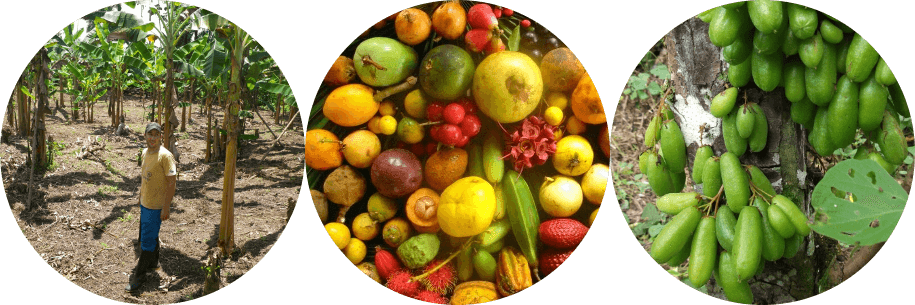
- #1 Why reforesting with fruit trees
- #2 Which species to cultivate
- #3 Seed collection and culture in nursery
- #4 Fruit tree grafting
- #5 How to plant fruit trees
- #6 Teaching native populations
TABLE OF CONTENTS
The Ecuadorian Amazon is a region of South-America where fruit cultivation is quite undeveloped. Nonetheless replanting fruit trees which allows production, transformation, marketing and fruit consumption is both a sustainable development way and a weapon to tackle deforestation. Ishpingo understands that well so we include fruit trees in almost all agroforestry projects we run.
#1 Why reforesting with fruit trees
Rich soils and a cool climate make the township of Tena a perfect place to grow tropical fruit species as illustrates the flourishing cocoa culture, considered as one of the best in the world.
Fruits can be utilized for family consumption or they can be sold locally, nationally and internationally.
The geographic location of Tena is interesting for the sale of fruits and other processed products on two different markets. Nationally, because of the new roads connecting Amazonia to several cities of the Sierra (Andean Mountains) but also internationally with the recent construction of Tena Airport.
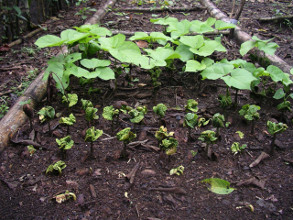
Fruits play a very important nutritional role in a region where diet is based on cassava and plantain banana. A wide variety of fruits harvested all year long would drastically improve the physical and mental development of children.
Tropical fruits sold on local market usually come from coastal regions. Selling them through short channels would limit the number of intermediaries and reduce freight costs thus ensuring better margins for local farmers.
Cultivating 25 different fruit tree species allows to care about biodiversity. It also decrease the spread of bacterial diseases and mushrooms that often arises in monocultures thus avoiding the use of pesticides.
Cultivating several different species reduces the consequences of a potential price fall such as what happened in the 90’s when the price of coffee collapsed. It might happen in the future for cocoa which is the main cash crop.
Cultivation operations, pruning and harvesting are distributed throughout the year in order to avoid as much as possible periods of inactivity and periods of intense labor.
Some kinds of fruit trees enter the production phase only 2 years after being planted.
Lots of fruits growing under the same weather conditions do not exist in Ecuador. Introducing some of those exotic species combined with underexploited local species, a sound knowledge of tree grafting, pruning and varieties selection would surely lead the farmers to profit.
There are a lot of derivatives products from fruits : juices, pulps, ice creams, jams, essential oils, floral extracts, dry fruits, etc… These derivatives allow an interesting economic valuation of fruits as well as a reduction of freight and storage costs.
#2 Which species to cultivate
Obviously, replanting fruit trees requires the creation of a substantial seed bank. Some of the seeds come from a few farms which use to cultivate fruit trees and are located both in the Amazon and in the coastal regions. The seeds of local fruit tree species are bought at the market in Tena city. We also collaborate with the INIAP (Instituto Nacional de Investigacion AgroPecuaria) which is the Ecuadorian Agronomic Research Center.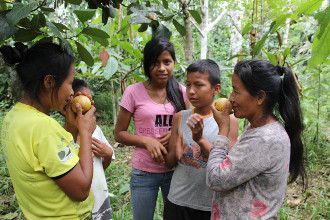 This organization sells us a great variety of fruit seeds, selected for their particularly interesting taste and their strong production capacity. The rest is bought to an American, Jim WEST, who has imported fruit species from all around the world. He has been owning a farm in the coastal region for 25 years. Exotic fruits fit with climat similar to what we can find in Tena and very few phytosanitary problems have been detected until now.
This organization sells us a great variety of fruit seeds, selected for their particularly interesting taste and their strong production capacity. The rest is bought to an American, Jim WEST, who has imported fruit species from all around the world. He has been owning a farm in the coastal region for 25 years. Exotic fruits fit with climat similar to what we can find in Tena and very few phytosanitary problems have been detected until now.
We now have at our disposal hundreds of different kind of seeds. We managed to taste at least once all of the fruit species we got. We also observed trees architecture, identified the optimal conditions for their growth (sun exposure, humidity, soil composition, etc…) in order to find them a place in our agroforestry systems.
Since half of fruit species we got are largely unknown in the Tena region, we use to bring fruit samples when visiting local farmers to let them know what they are about to cultivate. It allowed us to get an idea of their taste quality on a broad population. After something like 12 months we finally selected 25 fruit species.
The 25 different species:
The most popular fruits of the Amazon basin : sapote, Soursop, cherimoya, chicle muyu, mulchi, Arazá, guayabilla, copoaçu, water apple, almond-tree, borojó, jabuticaba, madruna.
Asian and African fruits : salak, mangosteen, ramboutan, jackfruit, menteng, rambai.
Fruits from the Ecuadorian coastal region : plum mango, coconut.
Citrus : oranges, mandarins, lemons, grapefruits. Please note that all citrus are grafted.
The number of plants cultivated for each species depends on : the economic interest, taste and nutritional qualities, dissemination, adaptation.
Even if we present our point of view about the advantage of each species, even if we point out the importance of biodiversity, the farmers still remain the ones who own the lands. The majority of them follows our advices and focuses on planting for self-consumption. Later, with time, they will be able to identify which species are best for commercial purpose. By the way all the farmers are very interested in grafted citrus.
#3 Seed collection and culture in nursery
Collected fruit seeds are sowed within the different tree nurseries. The precise number of sowed seeds is calculated according to : the quantity of plants needed by the farmers, the germination rate and the mortality rate in nursery.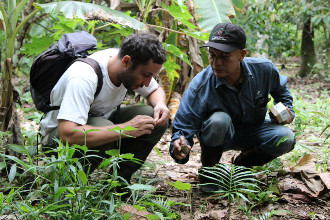
For species producing a large quantity of seeds and whose fruits have not been harvested, it is quite easy to collect young shoots right at the foot of the mother tree. It also save the time needed for seeds to become young shoots. It’s possible to transport those young shoots within moistened newspaper but one has to transplant them one day after at the latest. Please note that we grow the fruit tree species in the same nursery than the lumber tree species but we place them on the most sunny plots because fruit trees are heliophilous. When the plants have reached 50 to 80 cm we distribute them to the farmers. The time between gathering seeds and obtaining plants ready for final transplantation is about 1 year.
[ Results table not available on mobile devices ]
| List of cultivated fruit species | |||||||
|---|---|---|---|---|---|---|---|
| Common name | Scientific name | % of plants | Plants obtained | Germ % | % of survival | Germination (in days) | Seeds gathered |
| Araza | Eugenia stipitata | 2 | 180 | – | 80 | seedling | 225 |
| Borojó | Borojoa patinoi | 4 | 360 | 70 | 80 | 70 | 645 |
| Camu camu | Myrciaria dubia | 2 | 180 | 70 | 80 | 45 | 320 |
| Chicle muyu | Lacmella sp. | 2 | 180 | 50 | 80 | 25 | 450 |
| Cherimoya | Rollinia mucosa | 4 | 360 | 70 | 50 | 65 | 1030 |
| Coconut | Cocos nucifera | 2 | 180 | 90 | 90 | 70 | 225 |
| Cupuaçu | Theobroma grandiflorum | 3 | 270 | 30 | 70 | 10 | 1290 |
| Durian | Durio zibethinus | 2 | 180 | 50 | 50 | 20 | 720 |
| Soursop | Annona muricata | 4 | 360 | 70 | 70 | 65 | 735 |
| Sundrop | Eugenia victoriana | 2 | 180 | 70 | 80 | 90 | 320 |
| Jabuticaba | Myrciaria cauliflora | 6 | 540 | – | 80 | seedling | 675 |
| Jackfruit | Artocarpus heterophyllus | 2 | 180 | 90 | 90 | 15 | 225 |
| Graft lemon | Citrus sp. | 3 | 270 | 70 | 80 | 20 | 480 |
| Graft grapefruit | Citrus sp. | 5 | 450 | 70 | 80 | 20 | 805 |
| Madrono | Garcinia magnifolio | 3 | 270 | 70 | 90 | 65 | 430 |
| Graft mandarin | Citrus reticulata | 8 | 720 | 70 | 80 | 20 | 1290 |
| Mangosteen | Garcinia mangostana | 4 | 360 | 50 | 80 | 80 | 900 |
| Water apple | Syzygium aqueum | 3 | 270 | 70 | 80 | 30 | 115 |
| Menteng | Baccaurea dulcis | 4 | 360 | 70 | 60 | 25 | 860 |
| Mulchi | Eugenia subterminalis | 3 | 270 | 80 | 80 | 35 | 425 |
| Graft orange | Citrus sp. | 8 | 720 | 70 | 80 | 20 | 1290 |
| Rambutan | Nephelium lappaceum | 8 | 720 | 80 | 80 | 15 | 1125 |
| Salak | Salacca edulis | 8 | 720 | 60 | 50 | 30 | 2400 |
| Uvaia | Eugenia uvalha | 2 | 180 | – | 80 | seedling | 225 |
| Graft Sapote | Matisia cordata | 6 | 540 | 0.5 | 0.9 | 25 | 1200 |
| TOTAL | 100 | 900 | 18405 | ||||
#4 Fruit tree grafting
Grafting is the most commonly used technique in the culture of fruit trees. However it is not possible for each species. We use it for all kind of citrus (orange, mandarin, grapefruit, lemon) and for sapote. The process is quite complicated so we received a training performed by a technician from Shushufindi city.
Depending on species there are several different grafting methods. For citrus and sapote only one grafting technique is used, the top split graft. It works in about 90% of cases.
For a well-trained person it is possible to graft around 200 plants a day.
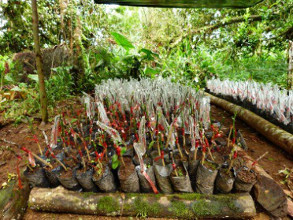 The benefits of grafting:
The benefits of grafting:
Citrus grafting helps to get very high quality trees. The lower part of the tree, called the rootstock, will develop strong and healthy roots. The rootstock comes from a local lemon species which particularly fits the surrounding conditions, both resistant to parasites and mushrooms. The top part of the tree, derived from the graft, will be the exact copy of the tree from which it has been taken. It will present the same properties : resistant to diseases, small-sized to facilitate harvesting, good production potential, large and tasty fruits.
For grafted citrus, fruit production begins 4 years after planting because grafts have the same cellular characteristics as the corresponding full-grown trees.
For sapote the required amount of time before the first harvest clocks backward from 10 to 4 years. Full-grown trees are about 6 meters high instead of 20. These two factors make possible the culture of sapote which used to be a very complicated task.
#5 How to plant fruit trees
Once the young trees are in possession of the farmers, they are free to plant them as they wish. During the distribution of the plants we use to present the different agroforestry systems we recommend.
We select the proper system(s) according to the specificities of each farm. In all cases we strongly advise to alternate different kinds of fruit trees to avoid diseases and optimize space. A Shrub and a tree are likely to compete each other in a reasonable way, both at the canopy and the root system level.
The different systems we propose:
Random planting within a fully reforested farm.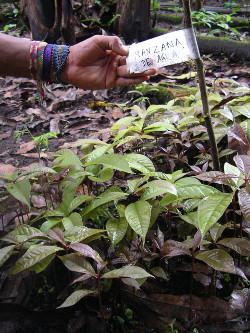 Some farmers have got small farms (less than 5 hectares) and don’t have plots large enough to sow. The will plant where there is still some space available.
Some farmers have got small farms (less than 5 hectares) and don’t have plots large enough to sow. The will plant where there is still some space available.
Planting on cocoa plots to replace dead cocoa plants. Fruit trees are planted alternately with cocoas where there is some free place available.
In most cases farmers have fallow lands. They shall use those lands to plant fruit trees combined with short cycle species. That way they can get incomes quickly thanks as well as forcing them to take good care of their lands.
The different plantation systems on fallow lands are:
Planting on fallow lands without combining different species. If the farmers are involved in others professional activities then they won’t have time to reforest with short cycle species. Completely clearing the plots before reforesting is not recommended because if there isn’t any vegetation cover during the first year a lot of young trees will die. While weeding the plots, the farmers should keep a sufficient tree cover to provide a lightly shaded environment.
Planting in association with cassava. Around one month before planting fruit trees, the farmers should weed their plots and plant cassava. As soon as the vegetation cover is sufficient they can begin planting young fruit trees. This method presents the best results in terms of plant survival because cassava cultivation forces the farmers to keep a weed-free land. Moreover that way the shade provided is optimum and fallen cassava leaves are a natural fertilizer. Cassava can be harvested after 9 months. Then the farmers will be able to plant cassava once more.
Planting in association with plantain banana. An anticipation of three months is necessary because plantain banana grows slower. Banana trees are planted every two meters. When they are tall enough it is possible to plant the other fruit trees at least at one meters from them. After one year one the banana bunch is harvested and the plant dies. This method is interesting because it is not necessary plant banana trees again. Indeed, young banana shoots come out at the foot of the mother tree come.
Planting in association with corn sowed with a stick (unlike the traditional broadcast sowing). A hole is dug every 60 cm with a wooden stick and 2 seeds are sowed into it. After one month corn is high enough and it becomes possible to plant fruit trees. Corn is harvested after 6 months and it becomes necessary to plant cassava or plantain banana instead.
Linear arrangement plantation with grafted cocoas. Cocoa cultivation is very common in this region of Ecuador. Grafted cocoa plants are given by the government and several different associative structures. The farmers usually cultivate cocoa on a monoculture basis. However there are other possibilities such planting cocoa alternately with fruit trees: one line of cocoa, one line of fruit trees. It helps reducing cocoa concentration which leads to massive use of chemical products in a region where farming is still mostly organic. Moreover some fruit trees will help providing light shade over cocoas as well as organic material such as fallen leaves. The deep roots of these kind of trees are also helpful since it brings up essential nutrients close to the surface.
Planting in a pasture. If the farmers want to convert their pastures into agricultural lands then they may consider planting fruit trees. This is the most difficult model since the plant will get full sun exposure as well as having a hard time competing with pasture weeds such as Dalis during the first two years. A cuttings providing shade is strongly recommended.
#6 Teaching native populations
Teaching farmers begins by presenting them all the fruit we’ve introduced above in order to let them taste fruit species they don’t know. We also teach them how to cook those fruits. A book of recipes is going to be released soon to achieve this purpose. 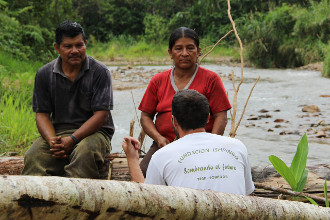 Training continues during collective works within the tree nursery of our teaching farm and during reforestation actions. We also organize training courses to teach grafting techniques and how to perform proper tree pruning.
Training continues during collective works within the tree nursery of our teaching farm and during reforestation actions. We also organize training courses to teach grafting techniques and how to perform proper tree pruning.
When the trees are distributed among farmers we also give them a practical guide. This guide contains the necessary informations to achieve proper cultivation for each fruit species. Tree size, how many years before the first fruit production, plantation distance, plantation arrangement depending of the chosen agroforestry system, transport precautions, etc… Please check out this guide we wrote in Spanish language (intended for local people) called « Guia practica para el cultivo de frutales ».
